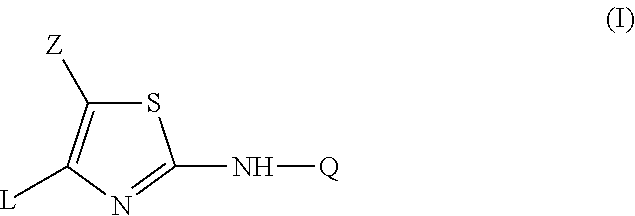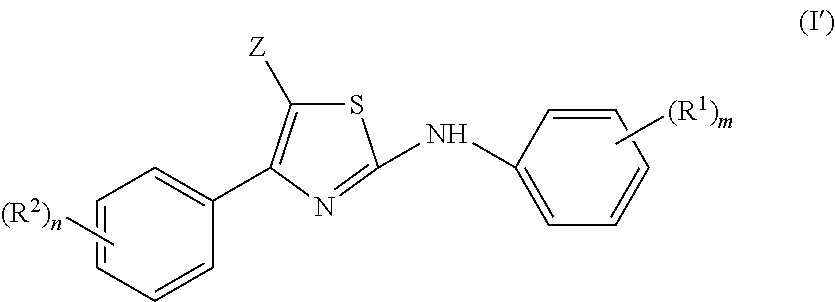2-aniline-4-aryl substituted thiazole derivatives
a technology of thiazole and aryl, which is applied in the direction of biocide, heterocyclic compound active ingredients, drug compositions, etc., can solve the problem of problematic treatment with nicotinic receptor agonists which act at the same site as ach
- Summary
- Abstract
- Description
- Claims
- Application Information
AI Technical Summary
Benefits of technology
Problems solved by technology
Method used
Image
Examples
example a1
a) Preparation of Intermediate 1
[0320]
[0321]A mixture of 2-bromo-1-phenylethanone (0.0402 mol) and [3-(trifluoromethyl)phenyl]-thiourea (0.0402 mol) in EtOH (q.s.) was stirred 4 hours at 70° C. The solvent was evaporated. The residue was triturated under EtOH, filtered off, treated with diluted ammonium hydroxide, then extracted twice with CH2Cl2. The separated organic layer was dried (MgSO4), filtered and the solvent evaporated, yielding 6.75 g (52%) of intermediate 1.
b) Preparation of Intermediate 2
[0322]
[0323]A mixture of intermediate 1 (0.0062 mol), a 40% aqueous formaldehyde solution (20 ml) and Et3N (5 ml) in THF (20 ml) was reacted for 30 minutes at 140° C. in a microwave oven, then cooled. Diluted ammonia was added and extracted with EtOAc (2×) and dried. The residue was triturated from a small amount of CH2Cl2, filtered off and dried, yielding 1.36 g of intermediate 2 (analytically pure material).
c) Preparation of Intermediate 3
[0324]
[0325]Intermediate 2 (0.00143 mol) was s...
example a2
a) Preparation of Intermediate 4
[0326]
[0327]A solution of benzoyl isothiocyanate (0.068 mol) in THF (50 ml) was added dropwise to a solution of 4-fluoro-3-methylbenzenamine (0.068 mol) in THF (150 ml). The reaction mixture was stirred overnight at room temperature. The solvent was evaporated. The residue was suspended in DIPE, filtered off, washed and dried (vacuum) yielding intermediate 4.
b) Preparation of Intermediate 5
[0328]
[0329]A mixture of intermediate 4 (0.055 mol) and a 1M NaOH solution (0.06 mol) in EtOH (500 ml) was stirred and refluxed for 1 hour. The reaction mixture was cooled and the solvent was evaporated. The residue was suspended in H2O, filtered off, washed and dried (vacuum), yielding 9.8 g (97%) of intermediate 5.
example a3
a) Preparation of Intermediate 6
[0330]
[0331]N,N,N-trimethylbenzenaminium tribromide (0.01 mol) was added to a solution of β-oxo-benzenepropanoic acid ethyl ester (0.01 mol) in THF (50 ml), then the mixture was stirred for 4 hours at room temperature, filtered and the filtrate was evaporated. The obtained residue was dissolved in EtOH (50 ml) and (2,4-dichlorophenyl)-thiourea (0.01 mol) was added. The reaction mixture was warmed and then was stirred and refluxed overnight. The solvent was evaporated and the residue was purified by column chromatography (eluent: CH2Cl2). The purest product fractions were collected and the solvent was evaporated. The residue was crystallised from DIPE, then the resulting precipitate was filtered off and dried, yielding 0.050 g (1%) of intermediate 6 (MP: 150° C.).
PUM
| Property | Measurement | Unit |
|---|---|---|
| temperature | aaaaa | aaaaa |
| temperature | aaaaa | aaaaa |
| temperature | aaaaa | aaaaa |
Abstract
Description
Claims
Application Information
 Login to View More
Login to View More - R&D
- Intellectual Property
- Life Sciences
- Materials
- Tech Scout
- Unparalleled Data Quality
- Higher Quality Content
- 60% Fewer Hallucinations
Browse by: Latest US Patents, China's latest patents, Technical Efficacy Thesaurus, Application Domain, Technology Topic, Popular Technical Reports.
© 2025 PatSnap. All rights reserved.Legal|Privacy policy|Modern Slavery Act Transparency Statement|Sitemap|About US| Contact US: help@patsnap.com



